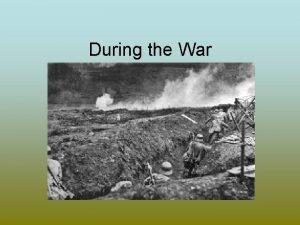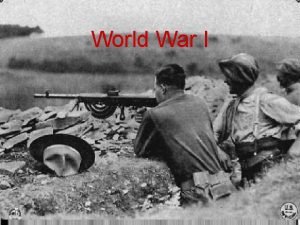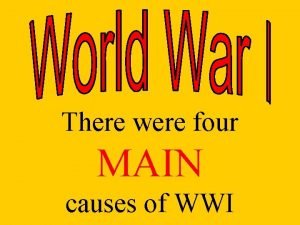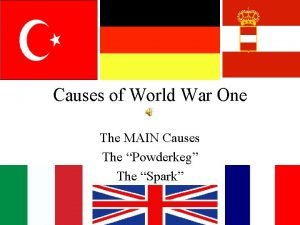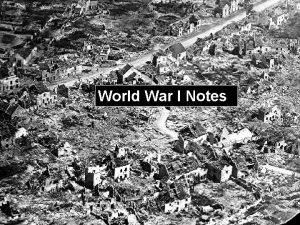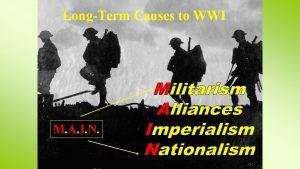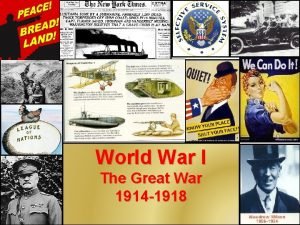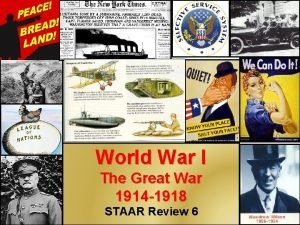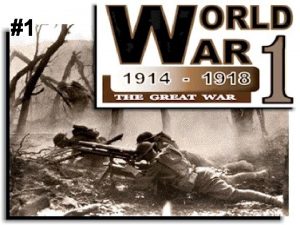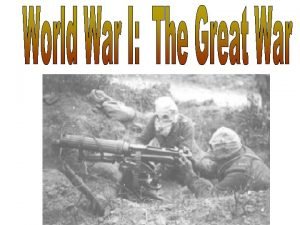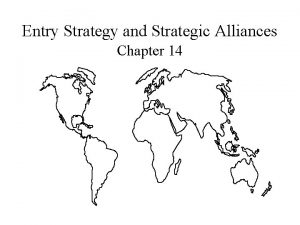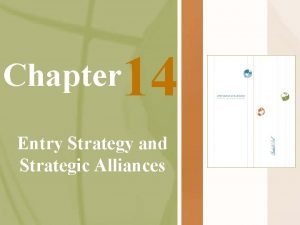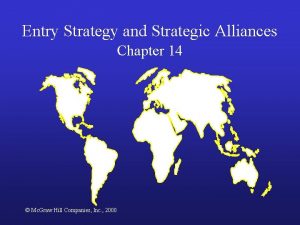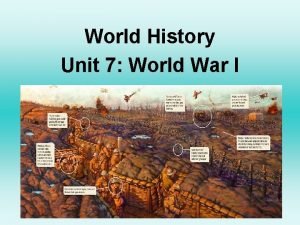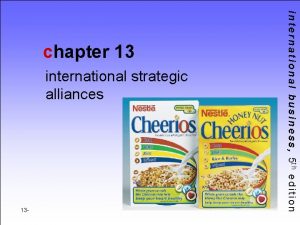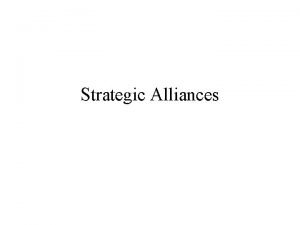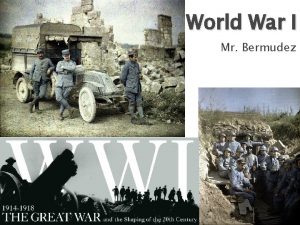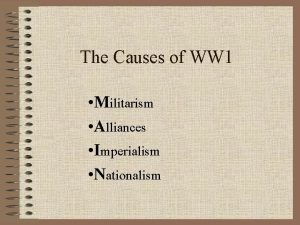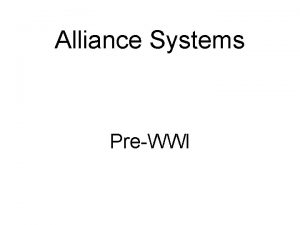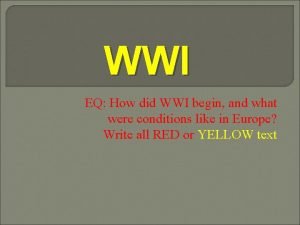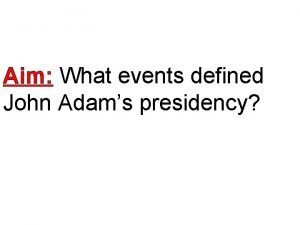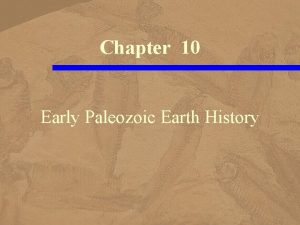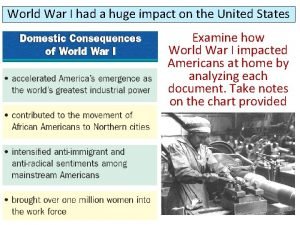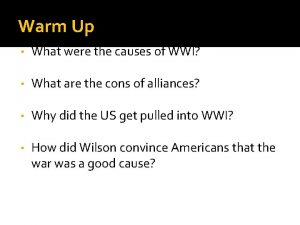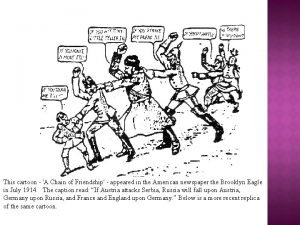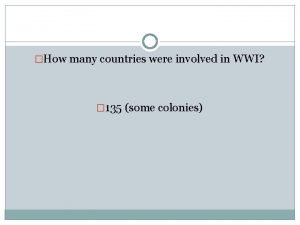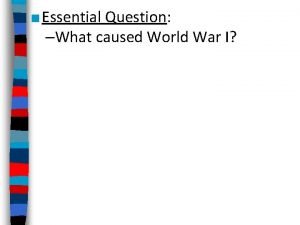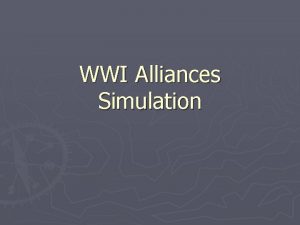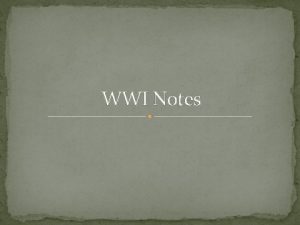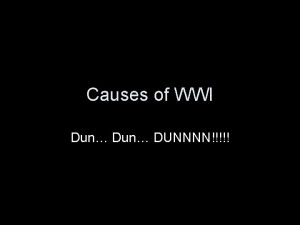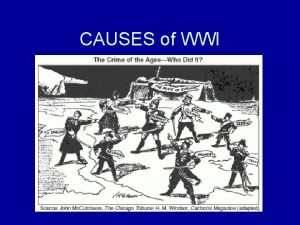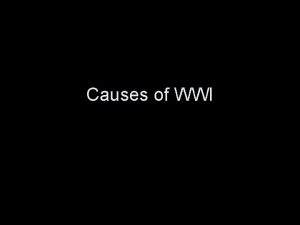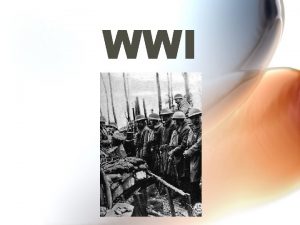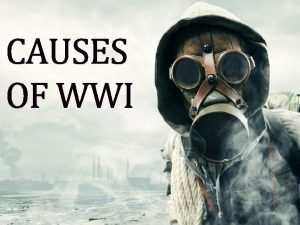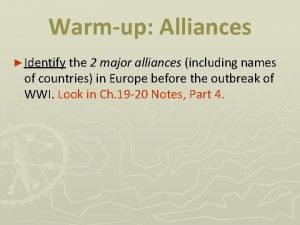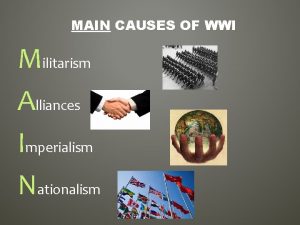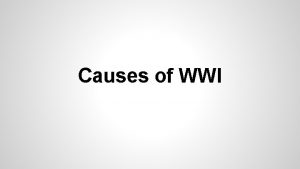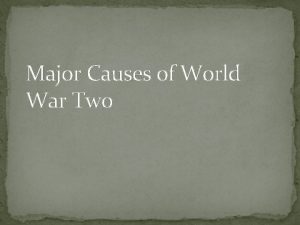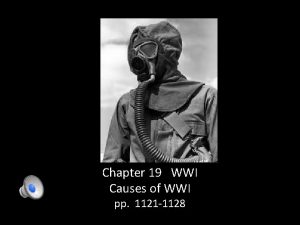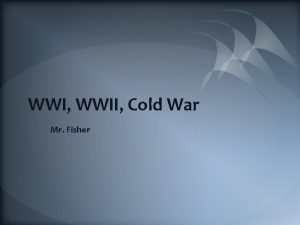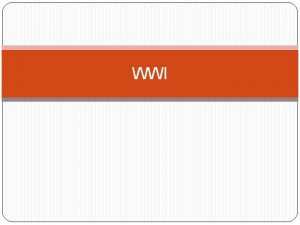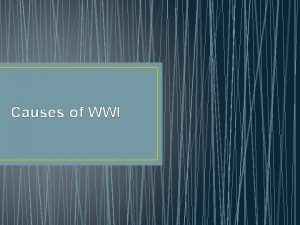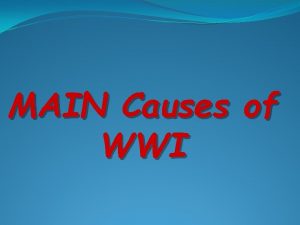WWI The alliances causes outcomes and major events










































- Slides: 42

WWI The alliances, causes, outcomes and major events of the Great War

Alliances Triple Entente Central Powers France Great Britain Russia (1914 -1917) United States (1917 -1918) Germany Austria-Hungary Ottoman Empire

Alliances

Causes Series of complicated alliances starting from 1815 Forming the Triple Entente and the Central Powers Tensions in the Balkans “The powder keg of Europe” Balkan wars were fought because the nations located there were each fighting for their own independence The alliances from above helped different sides in the Balkan wars increasing tensions Conflict over colonies For example in Africa where European countries were fighting for control over the land resources Assassination of Archduke Franz Ferdinand Heir to the Austro-Hungarian throne

Africa after European Imperialism

Nature of the War of Attrition A type of warfare by which both sides try to run each other out of personnel and materials WWI good example because instead of strategic tactics and attacks they used ‘Over the Top’ instead ‘Over The Top’ When the Commanding Officer blew his whistle all the soldiers under his command were ordered to jump out of the trenches and try to run across ‘No Man’s Land’ to the enemy trench and force them to retreat ‘No Man’s Land’ was the area in between the two sides trenches, it was usually full of barbed wire and uncovered, therefore the enemy could fire at will. Millions of soldiers killed this way.

Nationalism and the Pursuit of National Interest Finish this statement: The rise of nationalism and the pursuit of national interest were evident in the lead up to WWI in…

Major Events and Battles 1914 Franz Ferdinand assassinated (June 28 th) Outbreak of war (August 1 st) Schlieffen Plan implemented (August 3 rd) Battle of the Marne begins (September 6 th) 513, 000 casualties First battle of Ypres begin (October 18 th) 210, 000 casualties Mustard gas was first used as a major weapon

Major Events and Battles Trench Warfare began On the western front trenches stretched from the English Channel to the Alps 1915 Second Battle of Ypres begins (April 22 nd) Estimated 50, 000 casualties American ship “Lusitania” was sunk by German UBoats (May 7 th) 1916 Battle of Verdun begins (February 21 st) Estimated 755, 000 -976, 000 casualties

Europe 1915

Major Events and Battles Battle of Jutland begins (May 31 st) Largest Naval battle of WWI, 10, 000 casualties Battle of the Somme begins (July 1 st) Estimated 1, 120, 000 -1, 215, 000 casualties Lloyd George elected British Prime Minister (December 7 th) 1917 Germany begin their Unrestricted Submarine Warfare (USW) (February 1 st) A policy which stated that German U-Boats could sink any ship they thought was helping out the Entente’, even merchant ships

Europe 1916

Major Events and Battles USA declares war on Germany (April 6 th) Battle at Vimy Ridge (April 9 th-April 12 th) Battle of Ypres (3 rd) begins (July 31 st) Estimated over 585, 000 casualties Armistice signed between Russia and Germany (December 5 th) 1918 Treaty of Brest-Litovsk signed between Germany and Russia (March 3 rd)

Europe 1917

Vimy Ridge Memorial

Major Events and Battles Second Battle of the Marne (July 15 th) Start of the collapse of the German army Entente’ started to advance successfully (August 8 th) Armistice was signed (November 11 th) Ending WWI 1919 Peace Conference begins in Paris Treaty of Versailles was signed by Germany (June 28 th)

Europe 1918 -1919

WWI-By the Numbers Triple Entente Central Powers Total Men- estimated 33 million Casualties- 5. 25 million Wounded- 12. 8 million Civilian Deaths- 3. 7 million Total Men- estimated 24 million Casualties- 4. 4 million Wounded- 8. 4 million Civilian Deaths- 3. 1 million

WWI Video https: //www. youtube. com/watch? v=u. P_0 Dkp. FOKs

Jigsaw Activity Divide into Four (eight) groups Each group will represent one of the Big Four (i. e. Italy, Great Britain, France, United States) Using the textbook as a guide, discuss your country’s ambitions and goals with regard to the Treaty of Versailles: Was the aim to punish and humiliate Germany the key to long-term peace? Was the aim to create a humane treaty with Germany? Was the ultimate objective to obtain German lands for their country? Maintain access to its colonies and not be threatened by German naval fleets. Was the aim to get revenge against Germany? To protect the country against future attacks by Germany? *p. 148 -150

Spectrum of National Interests at the Treaty of Versailles Revenge! Make Germany Pay! (Clemenceau, Lloyd George) Obtain Lands (Orlando) Peace without victory (Wilson) (14 points)

Treaty of Versailles Complete the following chart (see page 152 ). Use page (pg. 149) to find the 9 summary statements and write in left hand column. In the right hand column, identify which nations would have been satisfied with each statement’s outcome. After completing chart, identify which nations would have been dissatisfied with the Treaty and why. Summary Statement: Nations Satisfied with Outcome:

Treaty of Versailles-Copy Down Signed on June 28 th 1919 Article 231 (War Guilt Clause)- Puts sole responsibility of the war on Germany and it’s allies, making them responsible to pay for damages caused by the war Forced to pay 132 Billion Reichmarks at the time By today’s standards that is 438 Billion US Dollars, only ten countries in the world today spend more than that per year Occupation of the Rhineland by Entente’ troops for 50 years

Treaty of Versailles-Copy Down Germany’s army could not be larger than 100, 000 troops and conscription was to be abolished Alsace and Lorraine were returned to France Originally France’s territories but they were won by Germany in the Bismarck wars in 1871 Creation of the League of Nations The first international political body

Treaty of Versailles-Copy Down The clauses in the treaty not only hurt Germany financially but they also greatly embarrassed a proud people. The clause that made Germany solely responsible for the war was the toughest to swallow These events and clauses can be debated when talking about the causes of WWII…As you will see

Treaty of Versailles-Copy Down France’s aims: security, reparation payments and Alsace and Lorraine Prime Minister Georges Clemenceau Great Britain’s aims: reparation payments and rebuilding the German economy for a trading partner Prime Minister David Lloyd George USA: Lesser reparation payments so they could continue to trade with Germany, League of Nations President Woodrow Wilson Canada? Led by Robert Borden

Wilson’s 14 Points Diplomacy reached publicly, no secret treaties Freedom of navigation of the seas Removal of trade barriers, equality of trade National armed forces decreased in size to the point where they are big enough only to provide domestic security Sovereignty of colonies back to the indigenous populations, and when turning it over their voice holds equal value to the colonizing country Evacuation of Russian territory, and let their people decide their own political futures Belgium will be restored and re built to its pre war state, allowing them to rule themselves Alsace and Lorraine be returned to France Italy shall be given clear lines of their national boundaries

Wilson’s 14 Points Austria and Hungary shall be allowed to autonomously develop The Balkan states (Serbia, Romania and Montenegro) will replace their borders with historical national lines and they shall be allowed to come to terms peacefully The Turkish portion of the current Ottoman Empire shall be given their sovereignty and the other nationalities under the Ottoman rule can autonomously develop unharrased. The Dardanelle mountain shall also be opened up to be a free trade route Poland shall be created from areas mainly populated by Poles. They shall be given a direct route to the sea and will be allowed to develop economically with the help of an International Organization A general body of nations shall be formed to uphold these principles and ensure international security

League of Nations Created on June 28 th 1919 First meeting on January 16 th 1920 Dissolved on April 20 th 1946 Was formed from Wilson’s 14 th point. It’s purpose was to stop events like WWI from happening again. It had 3 primary goals: Prevent war Disarmament of armies Settle international disputes through negotiations and arbitration

League of Nations Other sub goals of the League included: Labour conditions Just treatment of native inhabitants Control trafficking of drugs, persons, weapons, global health and prisoners of war And the protection of minorities in Europe At it’s peak the league had 58 members

Definitions Policy: A plan of action that has been deliberately chosen to guise or influence future decisions Domestic Policy: A plan of action that guides a governments decisions about what to do within a country. In Canada, domestic policy decisions may include changing federal laws, settling Aboriginal land claims, and spending more tax revenues. Foreign Policy: A plan of action that guides a government’s decisions about its official relations with other countries. Also called foreign affairs or external relations.

National Interest How does all this relate to National Interest?

National Interest

Canada in the War Conscription Crisis Wartime Voters Act Women’s involvement Propaganda/ War Measures Act and rationing Control of Foreign Policy Financing the War Legacy-In Flanders Field

Conscription Crisis. Copy Down Robert Borden wanted to increase Canada’s involvement in the War, but he promised at the outset no conscription Called an election Since he won the election he invoked conscription

Wartime Voters Act -Copy Down As a way to increase support for his government, Borden implemented the Wartime Voters Act just before the 1917 election This Act allowed wives, mothers or daughters of soldiers in the War to vote in their place

Women’s Involvement-Copy Down With most men overseas during the War millions of women had to go to work on farms and in factories to create the necessary supplies for a successful war effort.

War Measures Act. Copy Down Legislation that can be invoked during times of crisis. Allows the government to take away of limit citizens rights Meant for protection of collective security, rather than individual rights Forced rationing of food and fuel, censorship of the press, limiting freedom of speech

War Measures Act. Copy Down Internment Camp in Vernon B. C. Also allowed the government to imprison who they thought were enemies of the state. List included: Ukrainian Canadians German Canadians

Canada’s Foreign Policy From 1867 until the War broke out Canada did not have control over it’s own foreign policy decisions This meant, when the British declared War in Europe, Canada was immediately involved After Canada’s success at Vimy Ridge, we gained control over our own foreign affairs and even were allowed a seat in the peace negotiations in Paris.

Financing the War In an effort to raise money for the War, Canada’s government sold War Bonds to the citizens of Canada You would pay the government with the understanding they will pay you back in the future with interest

Legacy in Canada Every year Canada remembers on November 11 at 11: 00 AM, the sacrifice the soldiers made in the Great War This conflict was the birth of Canada as it is today by bringing the nation to the Worlds attention Canadian cemeteries and monuments in Europe
 Alliances wwi definition
Alliances wwi definition Alliances cartoon
Alliances cartoon What caused ww1
What caused ww1 Wwi
Wwi 4 causes of world war 1
4 causes of world war 1 World war i mania
World war i mania Main long term & immediate causes of wwi
Main long term & immediate causes of wwi Main causes of ww1
Main causes of ww1 4 causes for ww1
4 causes for ww1 List the allied powers and the central powers
List the allied powers and the central powers Cold war conflict
Cold war conflict Chapter 13 section 4 the power of the church
Chapter 13 section 4 the power of the church Chapter 13 section 4 the power of the church
Chapter 13 section 4 the power of the church Entry strategy and strategic alliances
Entry strategy and strategic alliances In terms of the build borrow or buy framework
In terms of the build borrow or buy framework Large-scale strategic commitments may
Large-scale strategic commitments may Strategy
Strategy Alliances and acquisitions
Alliances and acquisitions Mutually exclusive events vs not mutually exclusive events
Mutually exclusive events vs not mutually exclusive events Cost of world war 1
Cost of world war 1 Types of functional alliances
Types of functional alliances Doctrines et alliances
Doctrines et alliances Motivation for strategic alliances
Motivation for strategic alliances Russian involvement in ww1
Russian involvement in ww1 Picture of alliances
Picture of alliances Angeliki dedopoulou
Angeliki dedopoulou Sap university alliances
Sap university alliances Militarism alliances imperialism nationalism
Militarism alliances imperialism nationalism Alliance of three emperors 1881
Alliance of three emperors 1881 Proximate cause and ultimate cause
Proximate cause and ultimate cause Proximate and ultimate behavior examples
Proximate and ultimate behavior examples Where did wwi begin
Where did wwi begin What major events happened during john adams presidency
What major events happened during john adams presidency Ordovician period major events
Ordovician period major events Wwi webquest
Wwi webquest Wwi sides
Wwi sides Impact of wwi
Impact of wwi New technology in wwi
New technology in wwi New technology in wwi
New technology in wwi What does the chain of friendship cartoon mean
What does the chain of friendship cartoon mean How many countries were involved in wwi
How many countries were involved in wwi Nationalism in europe
Nationalism in europe Wwi background
Wwi background

